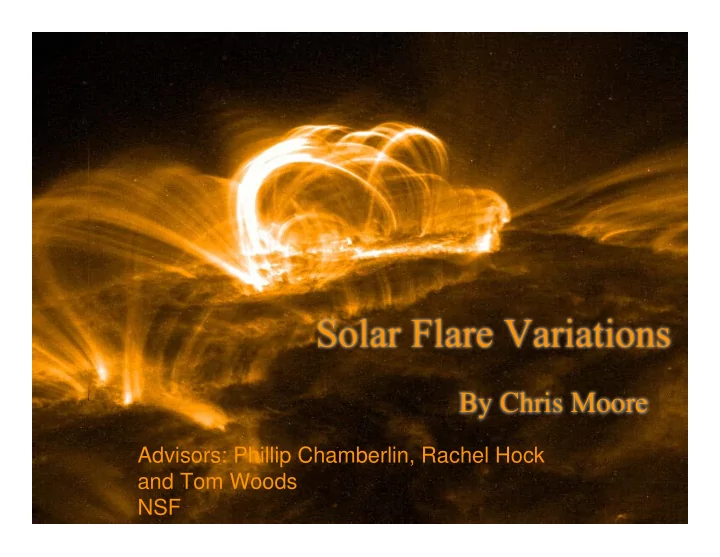

Solar Flare Variations By Chris Moore Advisors: Phillip Chamberlin, Rachel Hock and Tom Woods NSF
Outline � Overview of solar activity � Relevance � Proxies � Halloween flares � Procedures � Analysis � Conclusion
Goals � Find the total energy released in a solar flare � Energy composition associated in the impulsive and gradual phases � Find the contribution of the VUV to the total solar flare energy output in the TSI � Using wavelengths outside of the VUV to find its contributions to the TSI
So lar Cyc le � 22 ye ar magne tic c yc le � 11 min/ max sun spo t c yc le
Daily variations � Center-limb variations � Brighter for coronal emissions (36.5 nm) � Dimmer for Chromosphere (30.5 nm) and Photosphere (visible) emissions
Dynamics of Solar Flares � A magnetic flux tube emerges above the solar surface in active regions � Magnetic flux tube is more buoyant than the surrounding plasma � Eventually a filament of plasma is released after the stretching of the magnetic field lines reached their eruptive limit � This gives rise to the two phases of the solar flare
Dynamics of Solar Flares 2 � Energy is forced back into the atmosphere by magnetic reconnection, this is the energy input (Impulsive phase) � It is not visible until the Transition region, the corona is not dense enough � This influx of energy creates thermal heating in the atmosphere, seen in all regions � This is the slow phase (Gradual phase) of the solar flare Impulsive phase lasts � Impulsive phase lasts � around 5-10 minutes around 5-10 minutes Gradual phase lasts for � Gradual phase lasts for � several hours several hours
Impulsive and Gradual phases Neupert effect (1968) + + =
Why are Solar Flares important to the Earth • CMEs • Geomagnetic storms – Airlines (rerouting) – Disrupts: GPS, Satellites and communications (radio blackouts) – Power grids • NOAA SEC • Release energy up to 40 billion Hiroshima sized atomic bombs • Proton events – Auroras
How to study the Solar Atmosphere � F10.7 cm � Used since 1947 � Coronal continuum (Bremsstrahlung emissions) and rest of Atmosphere � Free-Free emission � X-ray and ultraviolet emissions display flare irradiance � VUV (0.1-200 nm) � Is ideal for analyzing the solar atmosphere
Proxies used � Coronal emission (36.5 nm) EUV � Coronal Continuum (0-7 nm) XUV � Transition Region (121.5 nm) FUV � Chromosphere emission (30.5 nm) EUV � Blackbody Continuum (175.5 nm) FUV
Instruments used for these proxies • On board the SORCE satellite • On TIMED SEE – Solstice II – EUV Grating • EUV and FUV Spectrograph (115-180 nm) (EGS) – X-Ray • (27-195 nm) Photometer System (XPS) • XPS • Wavelength varies by filter photodiode
FISM (Chamberlin P.C. 2005) � Model that estimates � Phil’s dissertation the solar irradiance in so he could get out the VUV (0.1-190 nm) of grad school � 1 nm resolution and a time cadence of 60 seconds - allows for modeling of solar flares � Includes solar cycle and rotation variations
Solar Cycle and Rotation � When modeling the 11 year solar cycle, it was helpful to remove the variations due to the solar rotation � Subtract the smoothed solar cycle data from the unsmoothed data to get the solar rotation variations � Makes plot easier to interpret and cleaner � - =
Solar variations � Solar rotations � Solar cycle � Transition region � Transition region � Max/Min ratio � Max/Min ratio 1.08 2.04 � Chromosphere � Chromosphere � Max/Min ratio � Max/Min ratio 1.11 2.63 � Blackbody � Blackbody continuum Continuum � Max/Min ratio � Max/Min ratio 1.15 1.03
Halloween Flares � Largest flares recorded in recent history � On October 28, 2003 X17 flare � Caused radio blackouts � GPS disturbances � November 4, 2003 X28 flare
Halloween Imp and Grad phases � Impulsive � Gradual Phase phase � Transition region � Max/ min ratio � Transition 14% region � Chromosphere � Max/ min ratio emission � Max/ min ratio 15% 50% � Chromosphere � Coronal continuum emission � Max/ Min ratio � Max/ min ratio 161x 45%
Scaling • For Transition region (121.5 nm) – Impulsive phase scaling factor • 123 – Gradual phase scaling factor • 156
Energy associated with flare � Impulsive phase (0-190 nm) � % of total energy VUV from flare � 8.9 x 10^ 30 (ergs) contributed to the � Gradual phase (0-190 nm) TSI from the VUV VUV (0-190 nm) � 1.2 x 10^ 32 (ergs) � 9.33% � Total (Impulsive + Gradual) � 1.29 x 10^ 32 (ergs)
Analysis of one proxy during, solar cycle, rotation and flare � Coronal Continuum � One of the highest magnitudes of increase � Transparent � Temperature � Bremsstrahlung continuum � Free-Free emissions
Future plans � Search for additional spectral contributions to the impulsive and gradual phase to the TSI � Ex. Hard x-rays (<0.1 nm) from RHESSI � Microwaves
References � FISM, Chamberlin P.C. (2003) � CSUI, Woods T.N., Kopp G., Chamberlin P.C., J ournal of Geophysical Research, Volume 111, Issue A10, CiteID A10S14 (2006) � FISM, Chamberlin P.C. Woods T.N., Epravier F.G. (2006) � SORCE, G.J. Rottman, T.N. Woods, V.L. George (2005) � Neupert W.M., Astrophysical Journal, vol. 153, p.L59 (1968) � Hudson, 1972 � NOAA � (GPS) Lean, 1997 � Modern Physics (second Edition) kenneth Krane, 1996
Recommend
More recommend